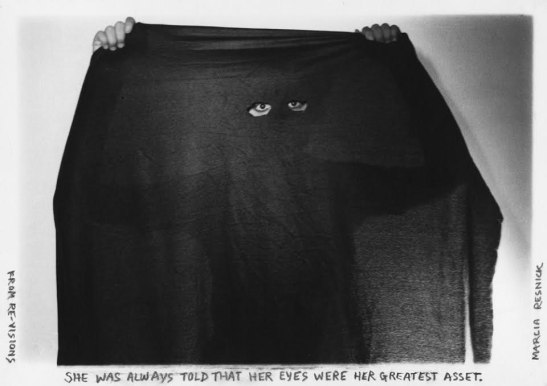Bad Girl: An Interview with Marcia Resnick
One of the pleasures of attending AIPAD: The Photography Show in New York a few weeks ago was the chance to see work by the artist Marcia Resnick in two different gallery booths. Resnick is the rare art photographer who uses humor in her work, whether to draw attention to life’s absurdities or make a political point. Many of her images do both at the same time, drawing the viewer in with whimsy and then hitting him or her in the solar plexus with an incisive message.
Resnick’s colorful career began in the 1970s, when she graduated from the California Institute of the Arts and moved back home to New York City. There, she got absorbed into a downtown scene of punks, musicians and performance artists, where drug use was a catalyst of creativity. After a car crash landed her in hospital for two weeks, she started contemplating her life and created a body of work called Re-visions, using photographs and text to probe her adolescent coming-of-age. Around the same time, she was photographing ‘bad boys’ of the downtown scene, training her camera on everyone from William S. Burroughs and Andy Warhol to Mick Jagger and David Byrne.

Mick Jagger, (c) Marcia Resnick
Resnick has continued to use text to complement her photographs, notably in the series Resnick’s Believe-It-Or-Not, in which she imagines alternative histories for people and objects. The Literate Lens caught up recently with her to discuss adolescent angst, word-image combinations and Mick Jagger’s piebald eyes.
I’m drawn to the humor in your work. Humor in art photography isn’t very common, and most of what I’ve seen has been by men, like Duane Michals and Elliott Erwitt. When did you discover you could be funny?
I went to grad school in California, where I was influenced by the dry humor in the art of John Baldessari, William Wegman and Duane Michals. Looking at the other side of trauma is a coping mechanism I ascribe to. Instead of being consumed by bitterness, I’m attracted to looking at the ludicrous and incongruous side of events.

From Re-visions, The Coach House Press, Toronto, 1978
When did you first combine text and images with artistic intent?
In grad school I did a series of drawings where I put in text that expressed my angst about things. Then when I got out, I did things where I wrote on my photographs. But mostly it came later.
What do you think it adds to the work when you use both?
Text and photographic images are both visual stimuli, and when they’re considered together, they provide a layering of meanings. The words amplify the truth implicit in the image and lend irony to that truth.

From Re-visions, The Coach House Press, Toronto, 1978
In your book Re-visions (The Coach House Press, Toronto 1978), humor comes from the tension between the captions and images. But it’s often pointed. For example, ‘She was told that her eyes were her greatest asset’ is accompanied by an image of your subject hiding behind a blanket with two eyeholes cut in it. You take a trope of traditional femininity and show how it can cause anxiety. This seems very feminist. Was that your intent?
I don’t like the term “captions.” When the words are as important as the visual image, I prefer to describe the words as “writing.” Since I lived during the heyday of feminism, I ascribe to the idea that women should embrace their independence.

From Re-visions, The Coach House Press, Toronto, 1978
Were you able to do that as an artist in the 1970s?
Yes. Luckily, when I got out of school, colleges were looking to employ women to balance their mostly male faculties, especially in male dominated fields like photography. I began teaching photography at Queens College, which provided me with the money for my very cheap rent (NYC was affordable in the 1970s) and the time to exercise my independence and make art.
 Re-visions, which you conceived when you were in hospital after totaling your car, is dedicated to Humbert Humbert, the narrator of Nabokov’s Lolita. I read Lolita when I was in graduate school for writing, and it blew my mind—for the voice, the prose style and the subject matter. When did you first read it, and what did it teach you, especially about sexual politics?
Re-visions, which you conceived when you were in hospital after totaling your car, is dedicated to Humbert Humbert, the narrator of Nabokov’s Lolita. I read Lolita when I was in graduate school for writing, and it blew my mind—for the voice, the prose style and the subject matter. When did you first read it, and what did it teach you, especially about sexual politics?
I read Lolita when I was sixteen, when I began college. I was sexually naïve and had been referred to as a “cock teaser,” which caused me to mistrust the male gaze. Subsequently, I was influenced by the visuals that accompanied the 1962 film. That is why my model is photographed behind heart shaped sunglasses, imitating Sue Lyons in the movie’s poster. I think that image represents the idea that behind the veneer of normalcy (the glasses), the traumas and sexual confusion of adolescence resides.
Back to the 1970-80s. There were a lot of women artists at that time doing wild things, like Karen Finley…

An early piece for Resnick’s Believe-It-Or-Not
Yes. I was influenced by Adrian Piper: she did performance art where she made long lists of things. When I was in the hospital, I woke up one day and the doctors had made marks and written things on my stomach. That fascinated me, and I started writing on my stomach. Also I couldn’t wash my hair in hospital, and after two weeks I took out my ponytail rubber bands out and my hair just stayed in ponytails. I made a piece about that.
At the same time you started photographing New York City’s ‘bad boys’: male artists, writers and musicians of the mid-20th century. You were fully immersed in their lifestyle, including the drug use, and in those years you got to hang out with, and document, the likes of William S. Burroughs, Allen Ginsberg, Mick Jagger and David Byrne. (This work was published in the book Punks, Poets and Provocateurs: New York City Bad Boys 1977-1982, Insight Editions 2015.) What made you start that project, and what was it like to be among such trailblazers?

John Belushi, (c) Marcia Resnick
After a solo trip to Egypt, where I encountered ungovernable, controlling and domineering men, I began to think about the archetype of the “bad boy.” After I got home, I began photographing the kind of bad boys I was intrigued by. The ones who were at once formidable and endearing. They lived on the edge. Some fell off that edge. Until that time, I hadn’t done much portraiture. The fact that I was a woman photographing men was crucial to the dynamic of my project. Male photographers were always photographing women in those days. The Women’s Liberation movement motivated me to turn the tables and photograph men.
You write that they had “a raw, edgy energy that came from reinventing themselves and their music.” Was it hard to get them to sit still for a portrait?

Mick Jagger, (c) Marcia Resnick
Well, a lot were posers who liked being photographed. Most were very fluid, they could move in front of the camera because they were performers. Once in a while there was a challenging session. Mick Jagger came in wearing mismatched clothes that I hated. At first we tried photographing him in a paper jumpsuit that my stylist friend had, but it didn’t work, so we stripped him down to his waist. I had a lot of little toys sitting around my loft, and at one point he grabbed a tiny airplane. He had one blue eye and a brown spot in his other blue eye, and a diamond in one tooth that led the eye down diagonally: all of these things worked on you subliminally when you looked at him.
You engineered a meeting between him, Andy Warhol and William Burroughs. That must have been quite something…
Yes. My friend Victor Bockris was doing a book about Burroughs’ meetings with other notables, and we fixed up a meeting between the three of them at Burroughs’ notorious place The Bunker. I took a picture of the three of them there. But it was an awkward meeting. Too many big egos in the room at once.

Jagger, Burroughs and Warhol at dinner. (c) Marcia Resnick
If that picture didn’t exist, one might think that meeting was an urban legend. Which brings us to Resnick’s Believe-It-Or-Not—it is full of tall tales, puns and made-up origin stories that are so entertaining I wanted them to be true. How did this come to be a feature in the Soho Weekly News? I’ve never seen anything like it in a newspaper before.
I often photographed objects I passed in the streets, and enjoyed imagining alternate, incongruent uses for them. After Re-visions I continued to create and photograph peculiar still lifes in my studio, and making up ironic stories to go along with them seemed only natural. Resnick’s Believe-It-Or-Not grew out of a column written for the Soho Weekly News by Cynthia Heimel who was on the editorial staff. She wrote Sex Tips for Girls which eventually became a book. I would provide a photograph to accompany her pieces, and that led to my harnessing space on the humor page for myself.

From Resnick’s Believe-It-Or-Not, (c) Marcia Resnick
Are you still a bad girl?
Well, yeah, to the extent I can be these days. At sixty-six, I still dress the way I did at sixteen. But the 1970s were sort of the last days of the counter-culture. Communication then depended on that intimate exchange between people in outlaw and underground groups. Now it’s all out there on the Internet, and things are much more sanitized. Of course there’s the Dark Net, but I don’t know much about that.
It seems to me that in today’s political climate, we could really use more artists who employ humor to point out the absurdities (and tragedies) of this world we’ve created. What are you working on now?
I don’t like to talk about projects I haven’t yet completed. I’m actively seeking to republish Re-visions, which has been out of print for decades. Its 40th anniversary will be in 2018. Any publishers out there want to take a look?
Marcia Resnick is represented by Deborah Bell Photographs and Paul M. Hertzmann, Inc.
2 comments on “Bad Girl: An Interview with Marcia Resnick”
Leave a Reply
Connecting to %s



Very interesting Sarah. Thank you Paola
fantastic Interview!!!